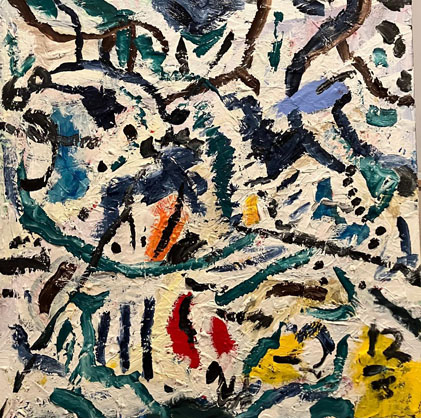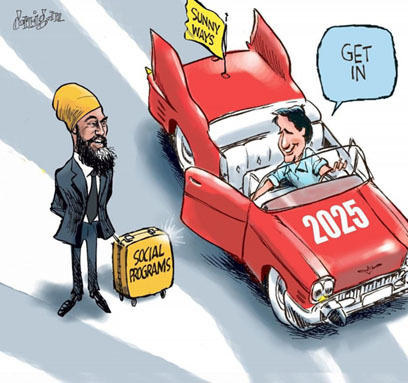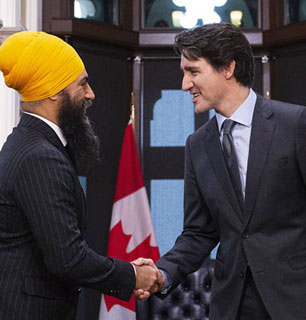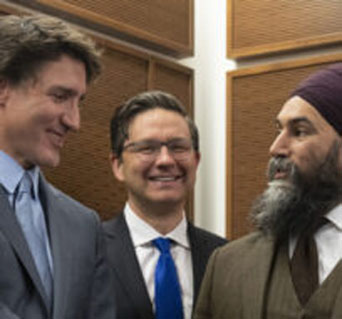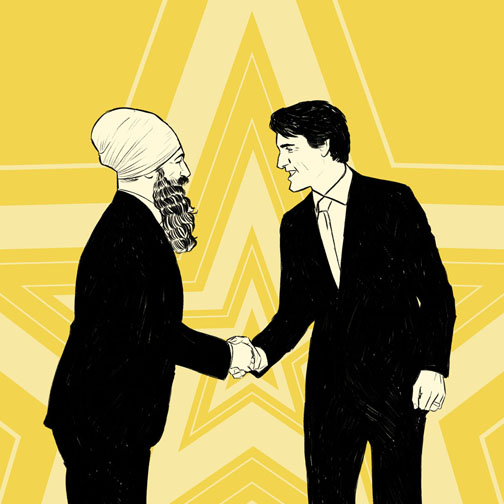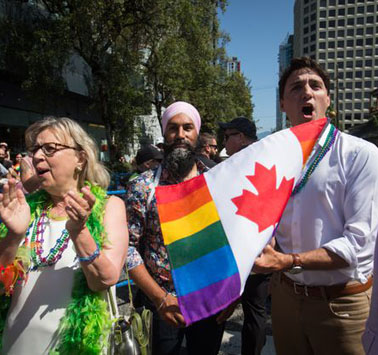Could some Liberal-New Democrat “non-aggression pact” really be the progressive wave of the future in Canadian federal politics this time ????
Apr 14th, 2023 | By Counterweights Editors | Category: Ottawa SceneCOUNTERWEIGHTS EDITORS, GANATSEKWYAGON, ON. APRIL 14, 2023. Wiser heads than ours have remarked that Canadian federal politics today reflects the consequences of “proportional representation” elections without actually having proportional representation.
Stephen Harper’s new Conservative Party of Canada had one majority and two minority governments between 2006 and 2015. And now Justin Trudeau’s Liberal Party of Canada will likely enough have one majority and two minority governments between 2015 and possibly as late as 2025.
Moreover, if the real world were ever to unfold as hypothesized in Éric Grenier’s “Weekly Writ for Apr. 12: What if the Liberal-NDP deal went past 2025?”, another minority government could likely enough result from the next Canadian federal election “on or before October 20, 2025.” Mr. Grenier, eg, provocatively asks us to contemplate the following future scenario :
It is a chilly March morning in 2025. Justin Trudeau and Jagmeet Singh appear at an Ottawa press conference. The confidence and supply agreement their two parties embraced back in March 2022, they say, has worked so well that it “will be extended into the next parliament — if Canadians re-elect a majority of Liberal and NDP MPs in the upcoming election. And to help them do that, the two parties have signed a non-aggression pact … ‘It’s not a merger, and it’s not a coalition,’ Trudeau says, as Singh nods.”
What does Liberal-NDP non-aggression pact in 2025 election mean?
This non-aggression pact just involves the two parties’ agreeing on a list of ridings (or electoral districts) in which there will be only one Liberal or NDP candidate in the 2025 election.
In each riding on the list the one party will be whichever of the two has the best chance of winning. And ideally it should be a place where the customary vote of the other party to the pact could also help the projected winner beat the Conservative candidate and supporter of (we agree) the appalling Pierre Poilievre. Mr. Grenier provides examples of both Liberal-winner and NDP-winner riding possibilities.
(And in assessing the likelihood that the Poilievre Conservatives just might win at least their own minority government in 2025, note that the Harper Conservatives managed this in 2006 with not quite 36.3% of the Canada-wide popular vote. Note as well that a March 9, 2023 Mainstreet Research poll gave the Poilievre Conservatives 37% of the vote — as did a February 15, 2023 Abacus poll — though the April 2, 2023 338Canada projection gives only 34%!)
As Mr. Grenier also notes, the concept of this kind of Liberal-NDP non-aggression pact is nothing new. It was especially in the air among some in both parties in the wake of the 2011 Canadian federal election, when the Harper Conservatives finally won their one majority government with 39.6% of the Canada-wide popular vote.
Then the concept of Liberal-NDP co-operation more or less vanished when the Justin Trudeau Liberals won a majority government with 39.5% of the popular vote in 2015.
But then the current Liberal Party of Canada proved unable to sustain a majority (of seats in the House) in the elections of 2019 and 2021.
Then in the early spring of 2022 Mr. Trudeau and Mr. Singh came up with the current confidence and supply agreement, to keep the second Trudeau Liberal minority government more securely in business.
And, whatever else, the aggressive right-wing leadership of the appalling Pierre Poilievre has most recently given the Conservatives an only intermittently interrupted leadership in opinion polls since this past fall 2022.
Would today’s Liberals and New Democrats ever agree to quite this much co-operation??
We want to make clear that we are or could be (all of us here!) pretty warm supporters of extending the current Liberal-New Democrat confidence and supply agreement beyond its prescribed 2025 end date, and of some companion Liberal-NDP non-aggression pact for the 2025 election.
We believe generally as well in some ongoing Liberal-NDP (or NDP-Liberal) co-operation in both Canada federally and Ontario provincially. Especially right now that seems the only way of keeping aggressively right-wing Conservatives from unleashing their dysfunctional agenda on various unsuspecting Canadian publics. (As in the case of the Ford Nation “PC” government in Ontario!)
We are for the moment nonetheless left with two questions : one big and perpetual, and the other hopefully much smaller and only intermittent!
The first is just : Will even the Trudeau Liberals and Singh New Democrats ever manage to agree on quite as much co-operation as envisioned in Éric Grenier’s “Weekly Writ for Apr. 12: What if the Liberal-NDP deal went past 2025?”
This seems to us a very deep and complex question, that has a lot to do with the exact state of ongoing opinion polls a little closer to Mr. Grenier’s fabled chilly March morning in 2025.
If at this future point either party has significantly more polling support than the April 2, 2023 338Canada popular vote projection of 31% Liberal and 19% NDP, say, then the attractions of single-party majority government visions of 2015 (and 2011) will simply be too strong.
And note how during the summer of 2015 it seemed that it would or at least could be “Tom” Mulcair’s New Democrats who would finally bring down the Harper Conservatives!
(It was only in the early fall of 2015, closer to the October 19 election date, that it was altogether clear this great achievement would belong to Justin Trudeau’s newly revived federal Liberals, blessed by his father’s Canadian liberal legend.)
Meanwhile .. on latest 338Canada seat projections Liberals and NDP together wouldn’t have a majority of seats in the House in any case !!!!
The eminent Philippe J. Fournier’s 338Canada popular vote and seat projections as of April 2, 2023 also raise a practical problem (or at least possibility) that no amount of co-operation between the two progressive parties (with the NDP somewhat more progressive than the Liberals, usually?) could overcome.

Mr. Fournier’s April 2 aggregation of recent public polling, that is to say, pegs the current popular vote at Conservatives 34%, Liberals 31%, and NDP 19%. Thanks to over-concentration of Conservative support on the Prairies (especially in Alberta and Saskatchewan), on this accounting the Liberals still wind up with 141 seats to the Conservatives’ 138. But the New Democrats have only 21 seats. And this means the two parties together would only have 162 seats in a House where 170 seats is a bare majority.
In fact on these numbers even the addition of 3 more Green seats to the confidence and supply agreement would not do the trick. The Liberal minority government would finally have to lean on the 35 seats 338Canada currently assigns to the Bloc Quebecois.
(And as a sign of just how much today’s Canadian federal politics with six political parties [five of whom actually win seats] reflects the consequences of “proportional representation” elections without actually having proportional representation, Mr. Fournier’s reporting now includes a list of “Seat projections of potential coalitions”. The top two April 2, 2023 contenders here are a Liberal-Bloc coalition with 176 seats and a Conservative-Bloc coalition with 173 seats!)
The current Liberal-New Democrat confidence and supply agreement, in other words, is anchored in the results of the 2021 Canadian federal election — where the Liberals took 160 seats with 36.2% of the popular vote, and the New Democrats won 25 seats with 17.8% of the vote. So the two progressive parties together had a strong majority of 185 seats with a clear 54% majority of the Canada-wide popular vote.
(Subsequent vagaries and vacancies mean that the Liberals right now have only 156 seats, but the NDP still has 25, for a comfortable enough governing majority of 181 seats.)
An October 20, 2025 election where the Liberals and New Democrats together did not get either a majority of the popular vote or of seats in the House would of course render the entire concept of Liberal-NDP co-operation of at least no governing consequence.
At the same time, even on the April 2, 2023 338Canada projections the Liberals and NDP together do get 50% of the popular vote — which is considerably larger than the 37% taken by the Conservatives and Peoples Party of Canada together.
Other things equal, Canada does still have at least a bare progressive majority! (And then if you add the current 338Canada Green numbers to the Liberals and New Democrats the progressive popular vote even here goes up to 54%. And then there’s the question of just how progressive is the Bloc Quebecois?? And then finally there’s the question of the people who still call themselves “Progressive Conservative”!)
